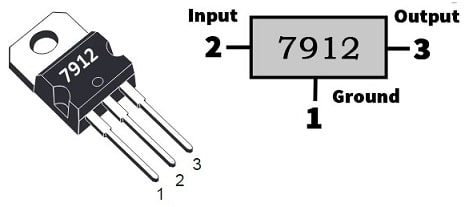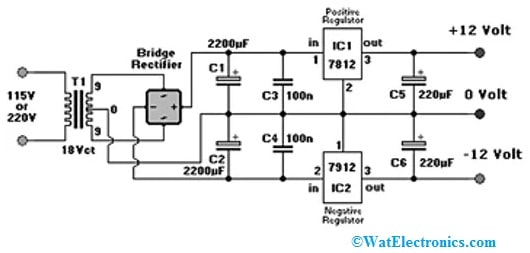A negative voltage regulator is an integrated circuit designed specifically to generate a stable negative output voltage which means the voltage is below the ground reference. So it is used where a stable negative voltage is necessary in particular audio amplifiers and op-amp circuits that require both power supplies. The main function of the negative voltage regulator is to regulate a negative incoming voltage to give a stable and lower negative output voltage, even if the input voltage varies. Thus, the best example of a negative voltage regulator IC is the LM7912 IC, pinout, features, specifications, and applications.
What is LM7912 IC?
An LM7912 IC from the LM79XX series is a negative voltage regulator available in a TO-220 package. This IC provides a negative 12V fixed voltage within a circuit. So number 79 in this IC indicates a negative voltage regulator, whereas number 12 indicates the specific -12V output voltage. This voltage regulator has protection features to avoid damage to the IC from overload conditions, such as thermal shutdown and internal current limiting.
How LM7912 IC Work?
The LM7912 IC works as a negative voltage regulator by using a fluctuating negative input voltage and generates a fixed negative voltage like -12V. Thus, this IC adjusts the current internally to maintain a stable output voltage even if the input voltage (or) load changes. So this can be achieved by a complex internal circuit which includes a pass transistor and extra features like thermal shutdown & short circuit protection to avoid harm within extreme conditions. So this voltage regulator chip is designed particularly to adjust negative voltage, thus the input voltage needs to be -ve polarity.
Pin Configuration:
The LM7912 IC pin configuration is shown below. This IC includes three terminals where the left-most pin of this IC is GND, the middle pin is the input pin & the right side pin is the output pin. Generally, we count IC pins from the left side to the right side thus the Pin-1 is left side; the Pin-2 is middle & the Pin-3 is right side. So the heat sink will be on the top of the IC.

LM7912 IC Pin Configuration
- Pin-1 (GND): This terminal provides common GND to both the input & output terminals of the IC.
- Pin-2 (V+): This is an input voltage pin of the IC where the unregulated voltage is provided to this pin.
- Pin-3 (V0): This is an output voltage pin where regulated output can be drawn from the o/p terminal.
Features & Specifications:
The features and specifications of LM7912 IC include the following.
- LM7912 IC is a negative voltage regulator IC.
- This IC includes three pins.
- It is available in the TO-220 package.
- Its minimum and maximum input voltage ranges from -14.5 Volts to -27 Volts.
- Its peak output current is 2.2 A.
- The average o/p current of this IC is 1 A.
- This IC includes short circuit current limiting & internal thermal overload and protection.
- It requires bypass capacitors for its stable operation.
- An output bypass capacitor improves the transient response of the IC.
- If aluminum electrolytes are utilized for bypass capacitors then their value must be 10μF (or) larger.
- Its operating junction temperature ranges from 0 C to +1250 C.
- The storage temperature ranges from -65 degrees C to +150 degrees C.
- The lead temperature will be 230 degrees C.
- Its ripple rejection is high.
- It has a fixed -12V output voltage
- The input voltage should lie in between -27V to -14.5V
- Protection circuits against short circuits and thermal overloads are incorporated inside this IC.
- Safe area protection is provided for output transistors.
- It has a high power supply rejection ratio and low noise.
- The output current is 1.5 A
- The output voltage tolerance is ± 4%.
- It has a low quiescent current which ensures good regulation.
Equivalents & Alternatives
Equivalent LM7912 ICs are; UA7912, KIA79012P, LM7905, LM7918, GL7912, LM7915, etc. So alternative LM7912 ICs are; LM337 and LM137 ICs.
How to use LM7912 IC in a Circuit for a Long Time?
To utilize an LM7912 IC within a circuit to get long-term performance and reliability, make sure that the input voltage of the IC stays in its fixed range from -14.5V to -35V. Do not drive any load of > 1.5 amps. So use a suitable heat sink with this IC to protect from overvoltage. Do not operate (or) store this IC in <-65 centigrade and > +150 centigrade temperature range. Thus, input & output capacitors must be added to this IC to filter noise. Proper design of this IC can extend its lifetime considerably.
12V Dual Regulated Power Supply Circuit
A 12V dual-regulated power supply circuit is shown below. This circuit is simple to design with few inexpensive components. So this circuit mainly uses two voltage regulator ICs LM7812 IC & LM7912 IC for voltage conversion. This circuit provides +12 V & -12 V supply from the mains AC supply.
The required components to make this circuit mainly include a transformer, 1N4001 diode, 2200uF, 220uF, 100n capacitors, LM7812 and LM7912 ICs. So connect this power supply circuit as per the diagram illustrated below.

12V Dual Regulated Power Supply Circuit
Working
The 12 V regulated dual power supply circuit using two voltage regulators is shown below. So both the regulator ICs in this circuit are from the LM78xx & LM79xx series which are accessible in the TO-92 package. So these regulator ICs perform step-down DC-to-DC converter tasks within electronic circuits. Generally, these are used in different power supply & battery charger circuits.
The LM7812 IC in this circuit is a positive voltage controller whereas LM7912 IC is a negative voltage controller. Thus, the transformer in this circuit is 220V AC (or) 115V AC. Here, appropriate heat sinks must be used with these ICs. The above regulated dual power supply circuit provides both +12Volts & -12Volts supply from the AC mains.
The T1 transformer in this circuit steps down the main voltage. After that, D1 to D4 diodes are used for rectification. So the C1 & C2 capacitors in the circuit are used for filtering and C3, C4, C7 & C8 are decoupling capacitors. Both the voltage regulators are used for voltage regulation where the previous is a +ve 12V voltage regulator and afterward is a -ve 12V regulator. Thus, the output of 7812 IC will be +12V whereas the 7912 IC will be -12V.
Advantages & Disadvantages
The advantages of LM7912 IC include the following.
- The LM7912 IC has thermal overload protection, o/p transistor secure operating area compensation & short circuit protection.
- It is a 1A high-stability voltage regulator.
- This IC is used as a power (or) reference voltage within both analog & digital circuits.
- This IC is used as a current limiter within various applications.
- This voltage regulator IC has low noise and an o/p polarity-reversal-protection circuit.
- This IC has a high power supply rejection ratio.
- It is a versatile voltage regulator IC.
- It provides -12 volts constant negative output voltage.
- This IC operates with an input voltage that ranges from -14V to -35V
- This IC needs a few external components for constant operation.
- This IC has a low quiescent current to ensure good regulation
The disadvantages of LM7912 IC include the following.
- This voltage regulator can heat up which causes problems when it is overloaded.
- The heat buildup exceeds the secure operating temperature of the remaining electronic components within the application circuit.
- This IC can drop up at full load to half a volt.
- It has limited built-in ESD protection.
- The terminals of this IC must be shorted jointly to avoid electrostatic damage.
Applications
The applications of LM7912 IC include the following.
- LM7912 voltage regulator IC can be utilized in analog & digital circuits like a power (or) reference voltage.
- This IC can be utilized as a current limiter within various applications.
- It can be used as a light controller with a silicon photocell.
- This IC can be used as a negative power supply within dual power amplifiers.
- This IC can be utilized as a current source.
Please refer to this link for the LM7912 IC Datasheet.
Thus, this is an overview of LM7912 IC, pin-out, features, specifications, and applications. This is a negative voltage regulator IC, and it is used in situations where negative voltages are required, like at sensors and in analog circuitry. This voltage regulator IC is available in numerous fixed voltage configurations like -5Volts, -12Volts, and -15Volts. However, these are chosen based on the requirements of the application. Its output current is 1Amp, but it can deliver up to 2.2Amps if an appropriate heat sink is utilized. Here is a question for you: what is LM337 IC?